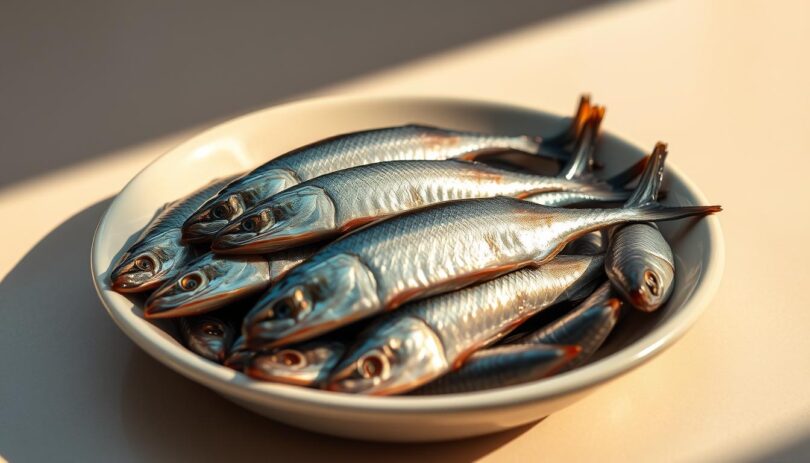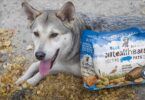Did you know over 3 million tons of small, oily fish are harvested globally each year? Among them, sardines stand out as a nutrient powerhouse—not just for humans, but possibly for pets too. This raises a common question for health-conscious pet parents: can these tiny fish play a role in balanced canine nutrition?
Packed with omega-3 fatty acids, vitamins D and B12, and minerals like calcium, these fish offer potential benefits for joint health, skin conditions, and immune function. Experts from sources like the Whole Dog Journal highlight their low mercury levels compared to larger seafood options, making them a safer choice when prepared properly.
However, introducing new foods requires care. Serving sizes depend on a pet’s weight, and canned varieties should be free of added salt or oils. Raw options also exist but demand strict safety protocols to avoid bacterial risks.
This guide explores how to responsibly incorporate sardines into meals, backed by veterinary insights and nutritional research. Discover practical tips to maximize benefits while minimizing risks for your furry companion.
Sardines: A Nutrient-Dense Superfood for Canines
These small, silver-scaled fish have nourished coastal populations for millennia, but their role in modern pet care is only recently gaining traction. Found in temperate oceans worldwide, over 21 species thrive in massive schools, making them one of nature’s most abundant marine resources. Their global availability and historical significance in human diets now extend to animal nutrition, particularly for four-legged companions.
An Overview of Sardines and Their Origins
Living near the ocean’s surface, these fish consume phytoplankton—a plant-based diet that minimizes toxin accumulation. This feeding habit, combined with their short lifespan, ensures lower mercury levels compared to larger predatory species. The Whole Dog Journal highlights this safety profile, noting their suitability as a protein source for pets.
Their schooling behavior supports sustainable harvesting practices, offering an eco-friendly option for pet owners. As a whole-food ingredient, they deliver calcium-rich bones and nutrient-dense flesh in every serving. This aligns with the “whole dog” philosophy promoted by experts, emphasizing minimally processed, biologically appropriate meals.
Historically preserved through salting or canning, today’s preparations prioritize pet safety. Reputable sources recommend varieties packed in water without added sodium. This evolution from human staple to premium pet supplement reflects growing awareness of species-specific nutritional needs.
Essential Nutrients and Health Benefits
The nutritional profile of this seafood makes it a powerhouse for pet diets. Packed with essential vitamins, minerals, and bioactive compounds, it supports everything from cellular function to visible vitality. Research shows these components work together to address common health concerns while promoting long-term wellness.
Key Vitamins and Minerals Found in Sardines
Selenium acts as a powerful antioxidant, protecting cells from damage. Vitamin D supports bone strength and immune response, while calcium contributes to dental health. These nutrients, combined with CoQ10—a compound that boosts energy production—help maintain organ function and metabolic efficiency.
Omega-3 Fatty Acids and Their Impact on Skin and Coat
EPA and DHA, two types of omega-3 fatty acids, reduce inflammation linked to allergies or arthritis. They also improve blood flow to hair follicles, creating a glossy coat. Studies show pets with regular intake develop fewer skin irritations and softer fur. Similar benefits appear in other fish-based foods, highlighting marine sources as ideal for dermatological health.
Complete proteins provide amino acids for muscle repair, while fatty acids support cognitive function. This synergy makes the fish a multifaceted supplement. Veterinarians often recommend it as part of balanced diets to address specific needs without synthetic additives.
Incorporating “sardines for dogs” into a Balanced Diet
When enhancing your companion’s meals, strategic inclusion of marine supplements can elevate nutritional value without overwhelming their system. Proper balance ensures pets receive essential nutrients while maintaining caloric control. Start by evaluating your pet’s current regimen—whether raw or commercial—to determine the best approach.
Optimizing Meals with Marine Supplements
For raw-fed pets, small portions of fresh fish can complement daily protein sources. Those on kibble may benefit from 2-3 weekly servings as a topper. Always adjust quantities based on weight—a teaspoon per 10 pounds prevents overfeeding.
Mix flaked fish with steamed vegetables or whole grains for added fiber. Pairing it with antioxidant-rich foods like sweet potatoes creates a nutrient-dense meal. Rotate proteins to avoid monotony and ensure dietary variety.
Experts recommend keeping supplemental items below 10% of total intake. This prevents imbalances while boosting omega-3 levels and protein quality. For guidance on similar additions, explore safe canned fish options that align with these principles.
Monitor your pet’s response to new ingredients. Gradual introduction helps identify sensitivities. Consult your veterinarian to tailor portions to specific health needs, ensuring every bite supports vitality.
Feeding Methods: Raw, Canned, and Freeze-Dried Options
Pet owners have three primary choices when adding marine protein to meals. Each form offers distinct advantages depending on lifestyle and nutritional priorities. Selecting the right option requires understanding preparation needs and nutrient retention.
Comparing Raw versus Processed Options
Fresh, whole fish retain maximum omega-3s and enzymes since heat processing degrades some nutrients. Look for suppliers flash-frozen at sea to lock in freshness. Canned varieties packed in water reduce sodium exposure compared to oil-based versions—always drain and rinse thoroughly before serving.
Freeze-dried products provide shelf-stable convenience while preserving 98% of original nutrients. Check labels for single-ingredient options without fillers. Avoid products with sunflower oil or artificial preservatives that counteract health benefits.
Best Practices for Safe Serving
Remove visible bones from fresh fish if your pet struggles with chewing. Soft bones in water-packed cans typically dissolve when mashed. For freeze-dried items, rehydrate with warm water to prevent choking.
Portion sizes should align with your companion’s weight—start with half a teaspoon per 15 pounds. Store opened cans in airtight containers for up to two days. Rotate protein sources weekly to maintain dietary balance and prevent boredom.
Safety Guidelines and Portion Control
Proper nutrition requires careful balance—too much of a good thing can lead to unintended consequences. While marine proteins offer valuable nutrients, understanding safety measures ensures pets enjoy their benefits without risks. Two critical factors demand attention: managing trace elements and tailoring servings to individual needs.
Managing Sodium and Mercury Levels
Though lower in mercury than larger fish, monitoring intake remains crucial. Opt for water-packed varieties and rinse thoroughly to reduce sodium. Limit servings to 1-2 times weekly to prevent mercury accumulation, especially for smaller breeds.
Portion Sizes in Relation to Your Pet’s Weight
Weight-based portions prevent overfeeding. A 20-pound companion typically handles one whole fish weekly. For pets under 10 pounds, start with half this amount. Gradually introduce new proteins—begin with a quarter teaspoon to check for allergic reactions.
Maintain a consistent feeding schedule, spacing servings 3-4 days apart. Track overall calorie intake to avoid weight gain. If skin irritation or digestive issues arise, pause immediately and consult your veterinarian. Precise measurements and patience help maximize benefits while minimizing risks.
Real-Life Feeding Tips and Community Insights
Pet communities often share valuable insights about nutritional tweaks that make a difference. Real-world experiences reveal how small adjustments can enhance a companion’s health without disrupting routines. Let’s explore practical strategies backed by both experts and everyday pet parents.
User Experiences and Advice from the Whole Dog Journal
Labrador owners in online forums report feeding one whole fish twice a week for improved coat shine. Smaller breeds like Chihuahuas typically handle half a fish weekly. The Whole Dog Journal suggests rotating proteins every few days to maintain interest and nutrient diversity.
Many mix flaked fish with kibble as a high-value treat. One user shared: “Adding a teaspoon to meals three days a week resolved my terrier’s dry skin.” Others blend it with coconut oil for dogs who need extra calories.
Adjust portions based on your companion’s daily activity. Highly active pets may benefit from slightly larger servings. Track changes over 2-3 weeks—look for softer fur, better digestion, or increased energy.
Keep an open mind if initial attempts face resistance. Try freezing mashed fish in silicone molds or baking into training treats. Consistency matters, but flexibility ensures long-term success.
Pairing Sardines with Other Nutritious Foods
Combining nutrient-rich ingredients creates meals that support overall health while keeping pets excited about mealtime. Strategic mixing enhances flavor variety and ensures balanced nutrition. Start by selecting complementary items that amplify key benefits without overwhelming delicate systems.
Mixing with Vegetables, Fruits, and Other Proteins
Blend flaked fish with steamed sweet potatoes or carrots for fiber-rich meals. For antioxidant boosts, add blueberries or spinach. Rotate proteins like wild-caught salmon to diversify omega-3 sources—this approach maximizes fatty acid absorption while preventing dietary boredom.
Adjust portion sizes when combining ingredients. If mixing with salmon, reduce each protein by 30% to maintain caloric balance. A 20-pound pet might receive one teaspoon of fish paired with two tablespoons of veggies. Always weigh components to avoid overfeeding.
High-quality sources matter. Choose water-packed options without additives to preserve nutrient integrity. When used alongside lean meats like turkey, these small fish elevate meals into complete nutritional packages. Track responses to new combinations, adjusting ratios based on energy levels and digestion.
Experiment with texture variations—mash fish into pumpkin puree or layer it over quinoa. Maintain 90% base diet consistency while using marine proteins as enhancers. This method ensures safety while delivering the advantages of omega-3-rich pairings.
Final Reflections on Enhancing Your Dog’s Diet with Sardines
Over time, small dietary changes can create lasting impacts on your companion’s well-being. Regular inclusion of nutrient-rich fish supports skin health and overall vitality. Studies and pet owner experiences show improvements in coat shine, mobility, and immune function when consistently added to meals.
Consistency matters most. After several years, pets often maintain better weight management and energy levels. Growing puppies benefit from early exposure to omega-3s for cognitive development, while seniors enjoy reduced joint stiffness. Even cats might occasionally enjoy these supplements if introduced safely.
The right way to integrate this protein involves matching portions to size and preferences. Mix flaked fish with regular food or offer it as a standalone treat. Always prioritize water-packed, low-sodium options to protect organ health.
Thoughtful meal planning keeps both mind and body sharp. Rotate proteins seasonally and review feeding practices every few months. This ensures diets evolve with your pet’s changing needs while maintaining nutritional balance.
Start small, stay observant, and celebrate gradual progress. Your dedication to quality nutrition today builds the foundation for a vibrant, active life tomorrow.
FAQ
Are sardines safe for dogs with food allergies?
Sardines are generally low in allergens compared to common proteins like chicken or beef. However, consult your veterinarian before introducing them if your pet has a history of sensitivities. Start with small amounts to monitor reactions.
How do omega-3 fatty acids in sardines benefit a dog’s coat?
Omega-3s reduce inflammation and support skin hydration, leading to a shinier, healthier coat. Regular inclusion can also minimize shedding and alleviate dryness caused by environmental factors.
Can puppies eat sardines?
Yes, but in moderation. Puppies require balanced nutrition for growth, so limit sardines to occasional treats. Ensure bones are soft (like those in canned varieties) to avoid choking hazards.










Leave a Comment